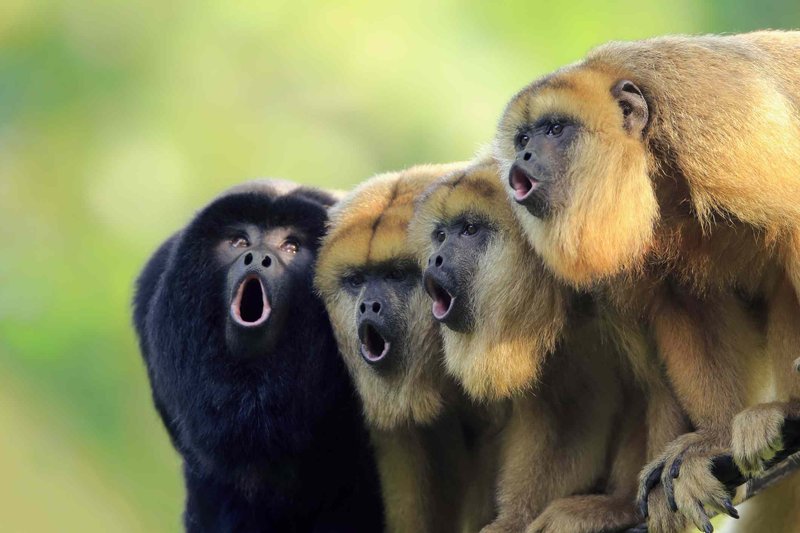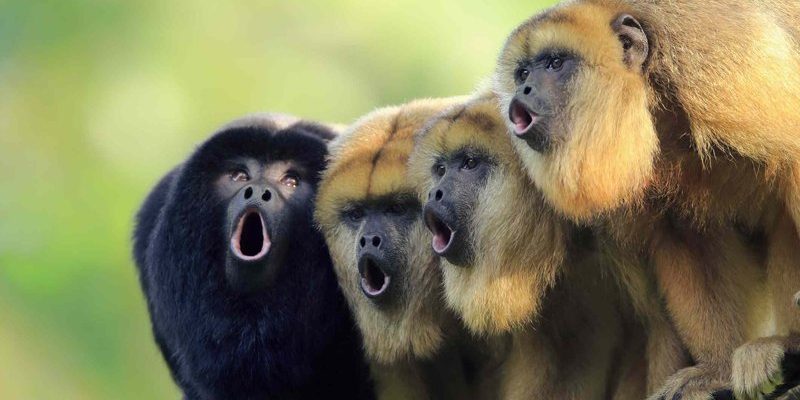
Understanding these similarities can be fascinating! Imagine if you were at a family reunion and spotted all the different personalities. Some relatives might have the same hair color, while others might share a quirky laugh. Similarly, animals like the guariba might look or act a bit like other species. In this article, we’re diving into ten animals that share traits with howler monkeys and exploring how you can tell each one apart. So, grab a cup of coffee, and let’s get started on this wild journey!
1. Spider Monkey
When it comes to social monkeys, the spider monkey is a strong contender. These agile creatures are known for their long limbs and prehensile tails, which help them swing gracefully from branch to branch. You might think they have a similar look to howler monkeys, but here’s the thing: spider monkeys have incredibly long arms and legs that give them a unique silhouette.
In terms of color, spider monkeys often sport a black or brown fur coat, while howler monkeys can be varied, including shades of reddish-brown or even blonde. Their vocalizations are also quite different. While howler monkeys are famous for their deep howls, spider monkeys communicate through a series of high-pitched whistles. So, if you hear a sweet melody in the treetops, it’s likely a spider monkey, not a howler!
2. Capuchin Monkey
Capuchin monkeys are the friendly faces of the monkey world. You might recognize them from movies and TV shows where they steal the scene—literally and figuratively! Capuchins have a more petite, stocky build compared to the lanky howler monkeys. Their fur is often a mix of beige and dark brown, which gives them a more diverse look.
One major difference is how they use their hands. Capuchins are known for their dexterous fingers, perfect for maneuvering items and getting into mischief. Howler monkeys, on the other hand, are more focused on moving through the trees rather than handling objects. If you spot a monkey skillfully using a tool, it’s probably a capuchin—howler monkeys are more about that soundtrack!
3. Squirrel Monkey
Next up is the squirrel monkey, a vibrant little creature full of energy. These monkeys are smaller than howler monkeys, typically weighing around 20 pounds, compared to the hefty howler. With their striking yellow-orange fur on the belly and dark limbs, squirrel monkeys definitely catch the eye.
Their vocalizations are far more varied than howler monkeys, who are mostly known for their deep calls. Squirrel monkeys chatter and squeal, often communicating their excitement. So, if you see a tiny bundle of energy making a ruckus, it’s likely a squirrel monkey leaving the howlers to their soulful serenades.
4. Tamarin
The tamarin is another unique relative of the howler monkey that stands out, especially with its adorable face and fluffy fur. Tamarins are much smaller and have a more delicate build. They often sport distinctive manes that make them look a bit like they’re wearing fancy hairstyles!
Tamarins are also very social, but their behavior is quite different from howlers. While howler monkeys tend to stick with their families and have larger groups, tamarins can form family units of just a few individuals. If you see a small group of monkeys interacting closely, they might just be tamarins rather than howlers.
5. Woolly Monkey
Now, let’s introduce the woolly monkey, which might just be the fluffiest of the bunch. They’ve got a robust build and thick, fur-covered bodies that give them a teddy bear-like appearance. Woolly monkeys are larger than howler monkeys, so if you see a big, fuzzy fellow hanging out in the trees, you might have a woolly on your hands.
In terms of vocalizations, woolly monkeys are known for their loud and distinctive calls, but they lack the deep, resonating howls of the howler. Their sounds might even remind you more of an alarm clock than an opera singer! So, if you hear a noise that’s more jarring than melodic, think woolly monkey.
6. Marmoset
You might get a kick out of the marmoset, a pint-sized primate that’s known for its playful antics. These monkeys are much smaller than howlers and typically weigh just a few pounds. They have a cute, round face that can’t help but make you smile.
Despite their fun size, marmosets are quite vocal, often making chirping sounds that are completely different from howler monkeys. If you see a tiny monkey bouncing around and making high-pitched noises, take a closer look—it could very well be a marmoset, not a howler.
7. Proboscis Monkey
Let’s take a detour to the forests of Southeast Asia to meet the proboscis monkey. What a character! These monkeys are known for their long, droopy noses and potbellies, which give them a unique appearance compared to the streamlined body of a howler monkey.
While their vocalizations are also quite loud, the proboscis monkey has a honking call that can be mistaken for a horn. They live in similar habitats as howlers but are more associated with mangroves and coastal forests. If you spot a monkey with a nose that looks like a cartoon character’s, you’re definitely looking at a proboscis!
8. Mandrill
The mandrill is probably one of the most colorful monkeys out there. With vibrant blues and reds on their faces, these guys are striking. Unlike the howler monkey’s solitary demeanor, mandrills are highly social and often found in large groups.
Mandrills tend to live in rainforests of central Africa, which is a bit different from the habitats favored by howlers. Their loud, barking calls are nothing like the melodious howls of their distant relatives. If you see a vibrant, social monkey being the life of the party, it’s likely a mandrill.
9. Rhesus Macaque
Rhesus macaques are known for their adaptability, often found in urban areas as well as forests. They are significantly smaller than howler monkeys and have a more slender frame. Their fur is typically a brownish color, and they have a more expressive face.
While howlers are known for their vocal prowess, rhesus macaques communicate through a range of grunts and clucks. If you see a group of monkeys hanging out near people, it’s probably a troop of rhesus macaques rather than howlers, who prefer a quieter life in the trees.
10. Japanese Macaque
Last but not least, we have the Japanese macaque, also affectionately known as snow monkeys. These are fascinating creatures that have adapted to cold climates and are known for their thick fur, which helps them survive in snowy conditions.
In terms of temperament, Japanese macaques are quite social, often seen soaking in hot springs during winter. Their calls are more varied and less resonant compared to the howler monkey’s deep vocalizations. If you spot a monkey enjoying a hot bath in the snow, it’s definitely a Japanese macaque, not a howler.
In conclusion, while the guariba (howler monkey) holds a special place in the hearts of many, it’s just one of many remarkable primates out there. Each of these animals has unique traits and behaviors that set them apart, and knowing how to tell them apart enriches our understanding of the animal kingdom. Whether you’re in a rainforest or just observing some wildlife documentaries, I hope this guide helps you appreciate the wonderful variety of our furry friends!

